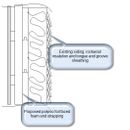Installing polyiso foil faced foam to inside of exterior wall
I am remodeling a 100+ year old victorian home and would like to add more insulation to the exterior walls.
The current wall construction was:
Original Cedar siding….. 2×4 wall cavity with rock wool insulation…… 1×8 tongue and groove sheathing…. plaster.
The plaster was removed in order to update wiring,,,,etc……
I don’t want to destroy the existing exterior siding on the home.
so…. my thought was to wrap the INSIDE of the exterior walls with 1″ foil faced Polyiso sheets and tape all joints, taking advantage of the foil face and tape as the VB.. I would also like to add 1×4 strapping to firmly secure the gypsum board to in order to reduce risk of screws popping and was reading that the air gap between the gypsum board and the foil face insulation would also act as an insulator to a certain extent.
Will this work?? Could I be causing a moisture issue in the wall? I noticed that 99.99% of all applications apply foam to the exterior rather than the interior, and very little discussion or documentation applying this product to the INSIDE of an exterior wall.
GBA Detail Library
A collection of one thousand construction details organized by climate and house part











Replies
Paul,
Plenty of people have installed rigid foam on the interior of their walls. This approach works.
The main disadvantage (compared to exterior rigid foam) is that it's harder to detail a continuous layer of insulation at the rim joists and partition intersections. But if your walls (and maybe parts of your ceilings) are opened up, you can address these areas too.
As with almost all energy retrofit work, it's important to pay attention to airtightness and air barrier continuity.